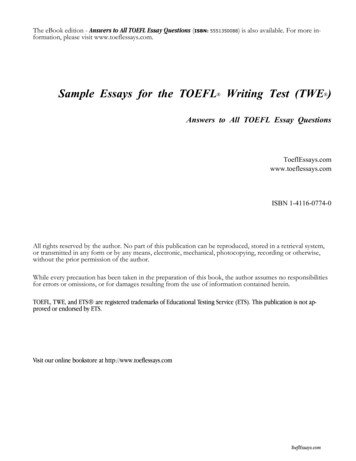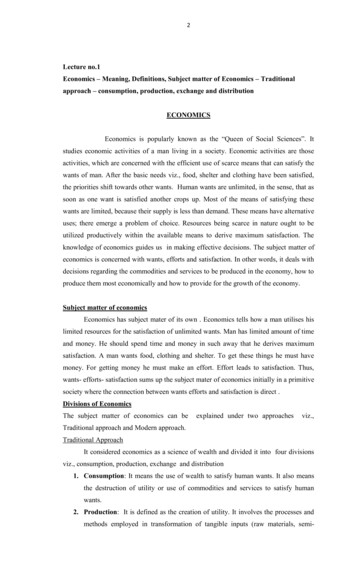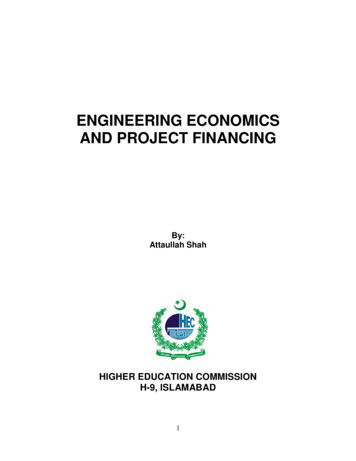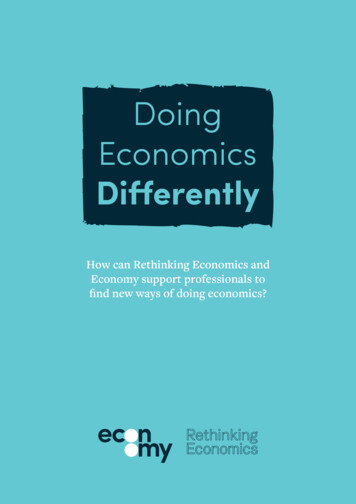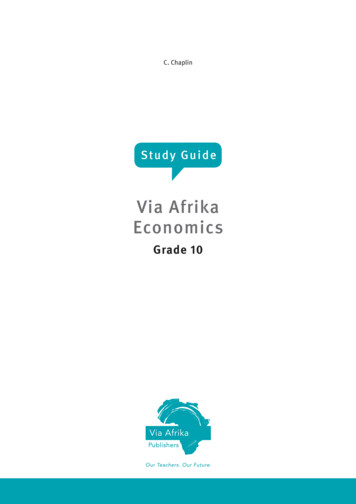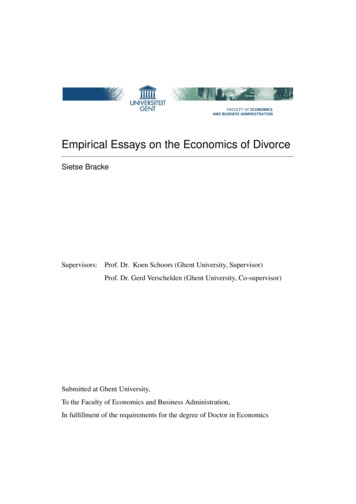
Transcription
Empirical Essays on the Economics of DivorceSietse BrackeSupervisors:Prof. Dr. Koen Schoors (Ghent University, Supervisor)Prof. Dr. Gerd Verschelden (Ghent University, Co-supervisor)Submitted at Ghent University,To the Faculty of Economics and Business Administration,In fulfillment of the requirements for the degree of Doctor in Economics
Doctoral committee:Prof. Dr. Marc De Clercq (Ghent University, Dean)Prof. Dr. Patrick Van Kenhove (Ghent University, Academic Secretary)Prof. Dr. Koen Schoors (Ghent University, Supervisor)Prof. Dr. Gerd Verschelden (Ghent University, Co-supervisor)Prof. Dr. Gerrit De Geest (Washington University)Prof. Dr. Ben Depoorter (Ghent University and U.C. Hastings)Prof. Dr. Mark Hoekstra (Texas A&M University)Prof. Dr. Dirk Van de gaer (Ghent University)Submitted at Ghent University,To the Faculty of Economics and Business Administration,In fulfillment of the requirements for the degree of Doctor in Economics
AcknowledgmentsThis dissertation marks the culmination of spending nearly a third of my life at theFaculty of Economics and Business Administration. Though performing researchis in essence - unfortunately - hard individual labour, it wouldn’t have been possible without the continuous support of a number of people to whom I am greatlyindebted.First of all, I would like to thank my supervisor prof. dr. Koen Schoors and myco-supervisor prof. dr. Gerd Verschelden for the opportunity I was given and thesupport while working on this dissertation. I was lucky enough to work with suchdiverse advisors: Koen; a non-stopping waterfall of ideas and Gerd; making a fewpoints, but always spot on. Thank you both very much. I would also like to thankprof. dr. Dirk Van de gaer who was also there from day one and whose scientificapproach is an example for many young researchers. My thanks also go out tothe other members of the jury, Prof. dr. Gerrit De Geest, Prof. dr. Ben Depoorterand Prof. dr. Mark Hoekstra for their comments and ideas during the guidancecommittee and the predefence. Their contributions made the papers both morerobust and provided me with different angles to look at my own work.As all people who ever obtained - or started - a PhD know: most PhD candidatesi
ACKNOWLEDGMENTSiiwill at some point face the infamous doctoral dip. I can say mine was quite fierce,yet I always looked forward to going to work; and this is mainly due to somepeople which I would particularly like to thank. First of all my former housemates,my (almost former) colleagues, and above all my best friends: Joost, Klaas andMarijn. From epic Risk battles in Louvain-la-Neuve, over inventing new card rulesduring lunch, to discussing economics: it was my privilege to do it with you guys.Though we are all slowly going our own ways, I hope we’ll always stay close.The same goes for my other friends of the brug - Benne, Daan, Renato, TDG and closely linked my Robbe Baert friends: Gijs, Koen and PJ. Comrades, nobodyf***s Chinese1 like you do! Furthermore, I would like to thank all my colleaguesat the departments of general and social economics for the great time I spent onthe first floor of the Hoveniersberg, with a special mention of the exceptionalatmosphere managers at the office; our very own dynamic duo: Martine and Eva.I would also like to take the opportunity to thank my parents who always encouraged me to study, providing me with ample opportunity and stimuli. Furthermore,I owe my parents - and both their partners - a lot of gratitude for the unconditionalsupport they provide me with in everything I undertake. Thanks also goes out tomy sister, though we don’t see each other that often I know I can always count onher.Finally, I would like to thank Gosia. Gosiu, wiem ż jestem czasami troszeczk edziki, ale ty jesteś trudna jak sto pi ećdziesiat. Ale, razem jesteśmy zajebiści. Jesteśmoje wszystko.Ghent, October 2013Sietse Bracke1 Forfurther information, I proudly refer to http://nl.wikipedia.org/wiki/Boerenbridge.
Table of ContentsAcknowledgmentsiTable of ContentsiiiList of FiguresviList of Tablesvii1Introduction11.1Introduction . . . . . . . . . . . . . . . . . . . . . . . . . . . . .11.2Contribution of the Dissertation . . . . . . . . . . . . . . . . . .41.2.1Chapter 2: “No-Fault Divorce and Rent-Seeking” . . . . .41.2.2Chapter 3: “Making Divorce Easier: the Role of No-Faultand Unilateral Revisited” . . . . . . . . . . . . . . . . .1.2.37Chapter 4: “Gender Differences in the Probability of PostDivorce Rematching and the Quality of the New Match” .9References11213No-Fault Divorce and Rent-Seekingiii
TABLE OF CONTENTSiv2.1Introduction . . . . . . . . . . . . . . . . . . . . . . . . . . . . .132.2Contract Theoretical Approach to Marriage and Divorce . . . . .162.3Legal and Institutional Framework in Belgium . . . . . . . . . . .212.3.1The No-Fault Unilateral Law of April 2007 . . . . . . . .222.3.2Duty of Maintenance under the New Law and Enforceability 242.3.3The New No-Fault Unilateral Law and Rent-Seeking Behaviour . . . . . . . . . . . . . . . . . . . . . . . . . . .26Data . . . . . . . . . . . . . . . . . . . . . . . . . . . . . . . . .272.4.1Data Collection . . . . . . . . . . . . . . . . . . . . . . .272.4.2Descriptive Statistics . . . . . . . . . . . . . . . . . . . .28Empirical Methodology and Results . . . . . . . . . . . . . . . .372.5.1Divorce Trajectory Choice . . . . . . . . . . . . . . . . .372.5.2Divorce Trajectory Choice: The Role of Innate Selfishness422.5.3Partner Alimony . . . . . . . . . . . . . . . . . . . . . .442.6Conclusion . . . . . . . . . . . . . . . . . . . . . . . . . . . . .492.7Appendix 1: Possible Biases in Self-Reported Function Special-2.42.5ization and Robustness . . . . . . . . . . . . . . . . . . . . . . .2.82.952Appendix 2: Estimating Alimony Transfers with OrthgonalizedDivorce Trajectory . . . . . . . . . . . . . . . . . . . . . . . . .55Appendix 3: Child Support Transfers . . . . . . . . . . . . . . . .57References613Making Divorce Easier653.1Introduction . . . . . . . . . . . . . . . . . . . . . . . . . . . . .653.2The Case of Belgium . . . . . . . . . . . . . . . . . . . . . . . .683.2.1Divorce Legislation Changes in Belgium: 1960 - 2009 . .683.2.2No-Fault and Unilateral Classification . . . . . . . . . . .70
TABLE OF CONTENTS3.3vData and Cointegration Analysis . . . . . . . . . . . . . . . . . .723.3.1Stationarity of the Time-Series . . . . . . . . . . . . . . .753.3.2Possible Endogeneity and Omitted Variable Bias . . . . .843.4Concluding Remarks . . . . . . . . . . . . . . . . . . . . . . . .863.5Appendix: Dickey-Fuller Simulated Critical Values Applicable tothe Sample . . . . . . . . . . . . . . . . . . . . . . . . . . . . .89References904Post-Divorce Rematching934.1Introduction . . . . . . . . . . . . . . . . . . . . . . . . . . . . .934.2Rematching . . . . . . . . . . . . . . . . . . . . . . . . . . . . .964.3Data Collection . . . . . . . . . . . . . . . . . . . . . . . . . . .994.4The Probability of Post-Divorce Rematching . . . . . . . . . . . . 1024.4.1Methodology and Data . . . . . . . . . . . . . . . . . . . 1024.4.2Results . . . . . . . . . . . . . . . . . . . . . . . . . . . 1094.4.3Quality of the Rematch . . . . . . . . . . . . . . . . . . . 1194.5Conclusion . . . . . . . . . . . . . . . . . . . . . . . . . . . . . 1254.6Robustness Checks . . . . . . . . . . . . . . . . . . . . . . . . . 1294.6.1Excluding Respondents Who Already Had A New MatchIn T1 . . . . . . . . . . . . . . . . . . . . . . . . . . . . 1294.6.2ReferencesOnly Taking into Account the First New Match . . . . . . 132135
List of Figures1.1Crude Divorce Rates in Selected European Countries (Eurostat) .32.1Possible Divorce Law Regimes . . . . . . . . . . . . . . . . . . .222.2Years married upon Divorce . . . . . . . . . . . . . . . . . . . .292.3Deviation from Perfect Reporting . . . . . . . . . . . . . . . . . .533.1log CRUDEDIV and log DIVPOPMAR . . . . . . . . . . . . . .743.2Model Comparison . . . . . . . . . . . . . . . . . . . . . . . . .844.1Earnings Distributions Men . . . . . . . . . . . . . . . . . . . . . 1224.2Earnings Distributions Women . . . . . . . . . . . . . . . . . . . 1234.3Difference in Quality between Former Spouse and New Partner . . 1244.4Difference in Quality between Former Spouse and New Partner(Conditional) . . . . . . . . . . . . . . . . . . . . . . . . . . . . 125vi
List of Tables2.1Direct Measure of Function Specialization . . . . . . . . . . . . .312.2Summary Statistics and Definition . . . . . . . . . . . . . . . . .362.4Choice of Divorce Trajectory (N 1,594) . . . . . . . . . . . . .392.3Summary Statistics by Divorce Trajectory . . . . . . . . . . . . .402.5Choice of Divorce Trajectory: Robustness checks . . . . . . . . .432.6Partner Alimony Transfers: Two-Part (Hurdle) Model . . . . . . .472.7Partner Alimony Transfers: Two-Part (Hurdle) Model . . . . . . .482.8Partner Alimony Transfers: Two-Part (Hurdle) Model . . . . . . .552.9Partner Alimony Transfers: Two-Part (Hurdle) Model . . . . . . .562.10 Child Support Payments (N 602) . . . . . . . . . . . . . . . . .593.1Divorce Legislation Changes in Belgium: 1960s - 2009 . . . . . .693.2Stationarity of the Series . . . . . . . . . . . . . . . . . . . . . .763.3Baseline Model . . . . . . . . . . . . . . . . . . . . . . . . . . .783.4Baseline with Legislation Dummies . . . . . . . . . . . . . . . .793.5Baseline with Duration . . . . . . . . . . . . . . . . . . . . . . .833.6Dickey-Fuller Simulated Critical Values . . . . . . . . . . . . . .894.1Rematching Statistics . . . . . . . . . . . . . . . . . . . . . . . . 103vii
LIST OF TABLESviii4.2Summary Statistics at T1 (Men) . . . . . . . . . . . . . . . . . . 1084.3Summary Statistics at T1 (Women)4.4Proportional-Hazard of Repartnering after Divorce (Men) . . . . . 1134.5Proportional-Hazard of Repartnering after Divorce (Women) . . . 1144.6Proportional-Hazard of Cohabitation after Divorce (Men) . . . . . 1174.7Proportional-Hazard of Cohabitation after Divorce (Women) . . . 1184.8Marital Homogamy among Divorced and New-Formed Couples . 1214.9Proportional-Hazard of Repartnering after Divorce (Men and Women)129. . . . . . . . . . . . . . . . 1094.10 Proportional-Hazard of Cohabitation after Divorce (Men and Women)1304.11 Proportional-Hazard of Repartnering after Divorce (Men and Women)1324.12 Proportional-Hazard of Cohabitation after Divorce (Men and Women)133
1Introduction1.1IntroductionEver since the second World War, divorce rates have been steadily on the risethroughout the Western world. Because of the risen incidence of divorce, and itsgrowing impact on various aspects of society, economists started paying systematic attention to “the family”. Applying modelling and econometric techniquesclosely related to the existing labour economics literature, family economics hasbecome a well-established sub-domain in economics.One of the pioneers of family economics is Nobel laureate Gary Becker. Becker’s1
CHAPTER 1. INTRODUCTION2seminal work in the Journal of Political Economy (Becker, 1973, 1974), followedby “A Treatise on the Family” (Becker, 1981, 1991) in which families are thoughtof in a utility maximizing framework leading to a market equilibrium paved theway for many scholars; economists, family sociologists and demographers. AsPollak (2003) puts it: “Gary Becker’s influence on the economics of the familyhas been pervasive. His ideas dominated research in the economics of the family,shaping the tools we use, the questions we ask, and the answers we give.”.Though Becker’s approach - as well as other non-conventional areas to whichthe economic approach was introduced to - was not without criticism (Lazear,2000). A prime example is feminist economist Barbara Bergmann who wrote afierce critique in the inaugural issue of the journal of Feminist Economics arguing that Becker’s framework builds on doubtful assumptions which in turn leadto conclusions confirming and even justifying the status-quo in gender inequality (Bergmann, 1995). Ever since Becker’s work, economists have been criticising and improving the economic modelling based on plenty of empirical researchregarding the micro-foundations, instituting family economics as a mature discipline.Divorce is naturally a hot topic within family (law and) economics. Because ofthe seemingly ever-rising divorce rates policy makers, as well as various opinionmakers and pressure groups, have had heated debates about legislation concerningdivorce and related. Unfortunately, these discussions remained rather shallow andpedantic since they are rarely based on hard empirical evidence. The main question which has therefore dominated the law and economics of divorce literatureis: if divorce legislation is made more lenient, do divorce rates rise?Though this question may sound quite easy to answer since macro data on divorcerates and legal changes are readily available, it poses several methodological ques-
CHAPTER 1. ustriaFigure 1.1: Crude Divorce Rates in Selected European Countries (Eurostat)tions. Illustration of that being that this debate started in 1986 in the AmericanEconomic Review (Peters, 1986) and only recently a consensus on the topic wasreached by Wolfers (2006). Though the discussion was long and hard-fought, itwas a scientific debate precisely because the data were publicly available.Another line of questions often posed is: how does divorce legislation influencefamily behaviour? These questions can be answered by modelling family behaviour à la Becker, or using contract theoretical reasoning as was done by LloydCohen in his seminal work in the Journal of Legal Studies (Cohen, 1987). However, it goes without saying that to answer such questions properly - i.e. withoutjust formalizing your a priori opinions - one needs high quality in-depth microdata. These data are, unfortunately, a little harder to come by.
CHAPTER 1. INTRODUCTION1.24Contribution of the DissertationWith the support of the Institute for the Promotion of Innovation by Science andTechnology in Flanders (IWT) the IPOS project was grounded. IPOS stands for“Interdisciplinary Project for the Optimization of Separation Trajectories”. Theproject was a cooperation between psychologists, legal scholars and economistsassociated with either Ghent University or the Catholic University of Louvain,which aim was to study divorce trajectories in Belgium/Flanders. One of the mainfeats of IPOS was the creation of a unique data set. From March 2008 till March2009 individuals going through divorce in 4 major Flemish courts were asked toparticipate in a survey. Though divorce can be a stressful and the courts are not avery common environment for most people, participation rates were surprisinglyfair. Moreover, comparing to official statistics by the Directorate-general Statisticsand Economic information (Statbel) demonstrates that the gathered population isvery close on observables (presence of children, age, marital duration). We alsosee quite a nice distribution of pre-divorce conflict, indicating that IPOS managedto also represent high-conflict divorces in the survey. Respondents were also followed longitudinally during the first 2 years following divorce. This substantialeffort provided us with the in-depth micro data needed to do proper empiricalwork on the economics of divorce.1.2.1Chapter 2: “No-Fault Divorce and Rent-Seeking”In the second chapter of this dissertation I conduct empirical work on the socalled Cohen thesis concerning quasi rent appropriation and destruction throughdivorce. Cohen (1987, 2002) demonstrates the time-inconsistency which exist iffunction specialization occurs within a household, i.e. when one partner specializes in labour market production and the other on domestic production. The part-
CHAPTER 1. INTRODUCTION5ner specializing on the labour market will reap the benefits of the marriage at anearly stage when he/she can focus solely on a career without having to care muchabout most importantly young children. The partner specializing on domestic production will only acquire the gains of the marriage at a later stage when the familyas a whole has a higher socio-economic status and the amount of required domestic production typically goes down. A clear incentive therefore exist for the labourmarket specializer to engage in rent-seeking behaviour and try to appropriate theother’s quasi rents. Quasi rents are defined as “a return to one party to a contract,above what the party could receive if the contract could be dissolved at will atthat moment” (Cohen, 1987). Put differently: a quasi rent can be seen as a returnon a sunk investment. If, however, the marital contract is broken the domestic production specializer’s quasi rent will be appropriated by the other spouse who doesnot have to uphold his/her end of the contract of which the lion’s share has to beprovided at a later stage in life. Note that quasi rent destruction takes place whenever the marital contract is broken if there is function specialization; regardless ofwhether or not the contract is broken with the specific intention of appropriatingthe other’s quasi rent.Several opinion makers have argued that since (full) function specialization israther a thing of the past, the Cohen thesis has become irrelevant. We test the empirical relevance in textitmodern times using the IPOS data set. Since September2007 couples divorcing in Belgium have to choose between two divorce trajectories: a consensual trajectory and a no-fault (unilateral) trajectory. When beforethe introduction of the new law a spouse wanted to engage in rent-seeking à laCohen, the choice was between either consensual or fault-based divorce. In a consensual trajectory where both spouses have to agree on the divorce and asset division the cost of rent-seeking may be fully internalized. When going through afault-based divorce the requirement for spousal alimony was that the financially
CHAPTER 1. INTRODUCTION6weaker spouse could maintain the standard of living. Though this is a vague notion, the idea is clear that rent-seeking behaviour à la Cohen will be penalizedby paying alimony. Now, by introducing the no-fault unilateral trajectory in 2007,divorce has become easier to obtain and marriage contracts have become less enforceable. Moreover, along with the trajectory also the requirements for alimonywere altered by introducing the concept of neediness. It goes without saying thatthe combination of no-fault unilateral divorce and the reforms regarding spousalalimony opens the door wide for rent-seeking behaviour à la Cohen.If the Cohen thesis is still relevant we would expect to find, ceteris paribus, couples with a larger inequality in the provision of domestic production in a no-faulttrajectory rather than a consensual trajectory. We estimate the probability of following a no-fault trajectory using a binary choice model (probit). We find clear evidence that couples with more extensive function specialization are ceteris paribusindeed more likely to opt for a no-fault divorce.Belgian legislators actually anticipated rent-seeking behaviour when introducingthe no-fault divorce trajectory. Art. 301 §3, subsection 2 states that when determining the height of partner alimony the court should also take into account thedecline of income of the spouses. To evaluate the magnitude of this decline, thelaw stipulates that the judge should take into account marriage duration, age ofthe spouses, and their behaviour during marriage concerning the organization ofthe family’s needs and care for the children. Because the law leaves a lot of roomfor discretionary power of the courts, we test if we can econometrically ascertaina compensation for the domestic production specializer’s quasi rent destruction.In other words, can we observe that in couples with a more extensive degree offunction specialization higher spousal alimony is indeed paid.We find, in line with legislation, that spousal alimony paid is higher if the inequal-
CHAPTER 1. INTRODUCTION7ity in the provision of domestic production is larger, ceteris paribus. Thus, the punishment mechanism for rent-seeking behaviour is indeed being used. The questionnow remains whether or not it is effective. If it would be effective - in equilibrium- no incentive would exists to engage in rent-seeking behaviour by opting for theno-fault trajectory. We shouldn’t therefore - ceteris paribus - find a difference between the consensual and the no-fault trajectory vis-à-vis function specialization.Because we still find a difference one could argue that the punishment mechanism is less than effective. However, because the new law was relatively new andexpected payoffs were still largely unknown, it could be that the equilibrium issimply not reached yet. Yet, anecdotal evidence of couples registering prenuptialagreements with regards to function specialization seems to suggest that it indeedless than effective. Follow-up research should re-evaluate this question after thelaw has been effect for a sufficient number of years.1.2.2Chapter 3: “Making Divorce Easier: the Role of No-Faultand Unilateral Revisited”In the third chapter we contribute to the discussion on the impact of divorce legislation on divorce rates. In other words: if divorce is made easier to obtain, willthe divorce rate go up? Since the 1980’s the debate has been on-going whether ornot the introduction of no-fault divorce in the USA during the 1960’s and 1970’s(the so-called no-fault revolution) contributed to the durable augmentation of thedivorce rates. The debate basically evolved around three points of concern: endogeneity of the legal reforms, the durability of the impact and the classificationof states. Wolfers (2006) was the latest to contribute to the debate. Wolfers performed an extensive revision of pervious work done and provided new evidencesuggesting that indeed the introduction of no-fault divorce raised the divorce rates,but that the effect was indistinguishable after more than a decade.
CHAPTER 1. INTRODUCTION8In the literature States are classified as having introduced no-fault divorce and/orunilateral divorce by using dummies: either the legislation is introduced or not.This approach was mimicked by Gonzalez and Viitanen (2009) and applied to investigate the impact of the introduction of no-fault and unilateral divorce groundsin Western Europe. It goes without saying that the classification of states is evenmore troublesome in a trans-national environment such as Europe than in theUnited States where divorce legislation across states show great similarities. Weargue that besides the purely legislative aspect of “making divorce easier” an important level of divorce legislation is overlooked when using a dummy-based approach: the procedural. We show using Belgium as a case study in a cointegrationframework that relying solely on a dummy classification of no-fault or unilateralmajor significant legislative changes will be missed. More specifically, Belgiumunderwent a significant divorce legislation modification in the mid ’90s whichraised the trend level of the crude divorce rate with about 18%. However, the nature of this change was purely procedural and had therefore nothing to do withneither no-fault nor unilateral divorce grounds.We also propose an alternative measure of easier obtainable divorce: the averageduration of the legal process per divorce legislation cohort. Though undoubtedlyimperfect, this measure has the advantage of at least capturing some of the variation in the underlying procedural framework. We find in the period between 1960and 2009 that per month the average duration drops, the divorce rate rose with1.4%. This is a quite sizeable coefficient given that the 1994 reform lowered theaverage duration of the legal process from 24.9 to 13.5 months.
CHAPTER 1. INTRODUCTION1.2.39Chapter 4: “Gender Differences in the Probability of PostDivorce Rematching and the Quality of the New Match”The fourth chapter of this dissertation deals with the topic of post-divorce rematching. Post-divorce rematching is of great importance because having a newpartner does not only significantly up happiness of recently divorced persons, italso serves as an important strategy to cope with the financial consequences ofdivorce (Jansen et al., 2009). Early work on the subject has been performed byBecker et al. (1977). However, the evidence presented is quite selective and theselection of variables seems to only aim at confirming the traditional role patternwithin families.In more recent work, the effect of a vast number of variables on post-divorcerepartnering has been tested. Nonetheless, because of data limitations the evidence presented in most papers remains fragmentary. Moreover, Becker et al.(1977) clearly demonstrate that a crucial variable is the length of separation priorto obtaining legal divorce if one wants to estimate a consistent timeline, given thatsearch for a rematch does not necessarily postponed until the couple is legally divorced. Becker et al. (1977) show that when this variable is not included it maylead to severely biased results; in their case certain coefficients even change sign.Yet, not a single study - to our knowledge - includes this variable.Using the longitudinal IPOS data set we estimate the probability to rematch after divorce for men and women in the first 2 years following divorce. Though arelatively short period, after 2 years about 52% of the respondents have a new partner and 30% cohabit with a new partner. In our sample men are about 5% morelikely to both repartner and cohabit after divorce. More interesting are the characteristics that make men and women more likely to repartner. We find substantialdifferences in drivers of rematching for men and women.
CHAPTER 1. INTRODUCTION10For both men and women being a (second generation) immigrant substantiallylowers repartnering odds. Also age reduces the probability to repartner, thoughthis effect is much more pronounced for women. Both men and women who indicated that they initiated the divorce have higher repartnering odds. Note that thisfinding is robust even when respondents who already had a new match at the firstcontact point are excluded. For men having a higher education and being longermarried previously also goes together with higher repartnering odds. For womenwe observe that women receiving alimony are less likely to repartner.Besides the probability to rematch we also look at the type of new match andthe difference with the old match. We find a severe decrease in homogamy interms of age. Where divorced men were on average 2 years younger than theirformer spouses, repartnered men are on average 7 years older than their new partners. Women in contrast tend to be more homogenous the second time around.Both men and women become exhibit increased homogeny in terms of earnings,albeit for different reasons. For men their new partner has on average higher earnings then their former spouse, whereas for women their new partner earns lessthan their former partner. This is also reflected in the quality of the new partner as measured by a construct similar to the Hollingshead Social Position Index(Hollingshead, 1957). We can clearly see when comparing the distributions of thedifference in quality of the new and old partner for men and women that menon average repartner up whereas women repartner down. Thus, where men andwomen are becoming more and more equal in terms of educational attainmentand earnings, there still remains a large discrepancy in repartnering after divorce.
ReferencesBecker, G. S., 1973. A Theory of Marriage: Part I. Journal of Political Economy81 (4), 813–847.Becker, G. S., 1974. A Theory of Marriage - part II. Journal of Political Economy82 (2), S11–S26.Becker, G. S., 1981. A Treatise on the Family. Harvard University Press, Cambridge, Massachusetts.Becker, G. S., 1991. A Treatise on the Family (Enlarged Edition). Harvard University Press, Cambridge, Massachusetts.Becker, G. S., Landes, E. M., Michael, R. T., 1977. An Economic Analysis ofMarital Instability. Journal of Political Economy 85 (6), 1141–1187.Bergmann, B. R., 1995. Becker’s Theory of the Family: Preposterous Conclusions. Feminist Economics 1 (1), 141–150.Cohen, L., 1987. Marriage, Divorce, and Quasi Rents; or, "I gave him the bestyears of my life". Journal of Legal Studies 16 (2), 267–303.Cohen, L. R., 2002. Marriage: The Long-Term Contract. In: Dnes, A. W.,11
REFERENCES12Rowthorn, R. (Eds.), The Law and Economics of Marriage & Divorce. Cambridge University Press, Ch. 2, pp. 10–34.Gonzalez, L., Viitanen, T. K., 2009. The Effect of Divorce Laws on Divorce Ratesin Europe. European Economic Review 53 (2), 127.Hollingshead, A. B., 1957. Two Factor Index of Social Position, New Haven, CT:Privately partneringand(Re)Employment: Strategies to Cope with the Economic Consequencesof Partnership Dissolution. Journal of Marriage and Family 71, 1271–1293.Lazear, E., 2000. Economic Imperialism. Quarterly Journal of Economics 115,99–146.Peters, H. E., 1986. Marriage and Divorce: Informational Constraints and PrivateContracting. American Economic Review 76 (3), 437–455.Pollak, R. A., 2003. Gary Becker’s Contributions to Family and Household Economics. Review of Economics of the Household 1, 111–141.Wolfers, J., 2006. Did Unilateral Divorce Laws Raise Divorce Rates? A Reconciliation and New Results. American Economic Review 96 (5), 1802–1820.
2No-Fault Unilateral Divorce andRent-Seeking12.1IntroductionIn western society divorce has become widespread,
4.6 Proportional-Hazard of Cohabitation after Divorce (Men) . . . . .117 4.7 Proportional-Hazard of Cohabitation after Divorce (Women) . . .118 4.8 Marital Homogamy among Divorced and New-Formed Couples .121 4.9 Proportional-Hazard of Repartnering after Divorce (Men and Women)129 4.10 Proportional-Hazard of Cohabitation after Divorce (Men and .



